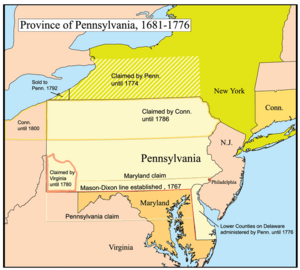Pennamite–Yankee War facts for kids
Quick facts for kids Pennamite–Yankee War |
|||||||
|---|---|---|---|---|---|---|---|
| Part of American Revolutionary War | |||||||
 Pennsylvania and the competing land claims of other states |
|||||||
|
|||||||
| Belligerents | |||||||
| Pennsylvania Pennamites | Connecticut Yankees | ||||||
| Commanders and leaders | |||||||
| Captain Christie | John Franklin | ||||||
| Strength | |||||||
| Unknown | Unknown | ||||||
| Casualties and losses | |||||||
| 1 killed | 2 killed | ||||||
The Pennamite–Yankee Wars were a series of fights that happened between 1769 and 1784. These wars were about who owned the Wyoming Valley. This land was along the Susquehanna River. Settlers from Connecticut (called Yankees) and settlers from Pennsylvania (called Pennamites) both wanted it.
The conflicts included the First Pennamite War (1769–1770), the Second Pennamite War (1774), and the Third Pennamite War (1784).
Why the Fight Started
The Wyoming Valley was a disputed area from the very beginning. The Netherlands thought the Susquehanna River was the border for their land. But in 1662, King Charles II of Great Britain gave this land to Connecticut.
Later, in 1681, King Charles II also gave the same land to William Penn. This was for the colony of Pennsylvania. So, both colonies had official papers, called charters, that said they owned the same territory.
For a while, this wasn't a big problem. Native American groups like the Susquehannock lived there. They made it hard for anyone to settle. But by the mid-1700s, more settlers wanted the land. This made the overlapping claims a serious issue.
Land Deals and Settlers
Both Connecticut and Pennsylvania bought the same land from different Native American tribes. Connecticut sent settlers to the area in 1754. However, a big war called the Seven Years' War delayed their plans.
In 1768, the Iroquois Confederacy changed their mind. They had sold the land to Connecticut's Susquehanna Company. Now, they sold it again to the Penns of Pennsylvania.
Despite this, Yankee settlers from Connecticut started a town called Wilkes-Barre in 1769. Pennsylvania's Pennamite groups tried to force them out. These attempts led to the First Pennamite War (1769–1770). More conflicts followed, including the Second Pennamite War in 1775 and the Third Pennamite War in 1784.
In 1771, King George III confirmed Connecticut's claim. By 1773, more Connecticut settlers built a new town. They named it Westmoreland. But in December 1775, Pennsylvanians refused to leave. The Pennsylvania militia forced them to go.
How the Conflict Ended
The fighting between Connecticut and Pennsylvania continued. This was even after the American Revolution ended. In 1782, the Continental Congress stepped in. This was the governing body of the new United States. They looked at the claims and decided that Pennsylvania owned the land.
This was the only time Congress settled a dispute between states under the Articles of Confederation. But Pennsylvania still tried to force the Yankees off the land in 1784. This started the Third Pennamite War. Both Connecticut and Vermont sent people to help the Yankee settlers.
During this time, a Pennsylvania general named John Armstrong promised peace. He said he would make sure everyone got fair treatment. But once the Yankees were defenseless, he took them prisoner. This unfair action made many people support the Yankees. So, the Pennsylvania leader, Alexander Patterson, was removed.
Arguments continued for a few more years. Finally, in 1788, the Pennsylvania Legislature made a decision. They confirmed that the settlers could keep their land. The long conflict officially ended in 1799. The Wyoming Valley became part of Pennsylvania. The Yankee settlers became Pennsylvanians, and they had legal rights to their land.



